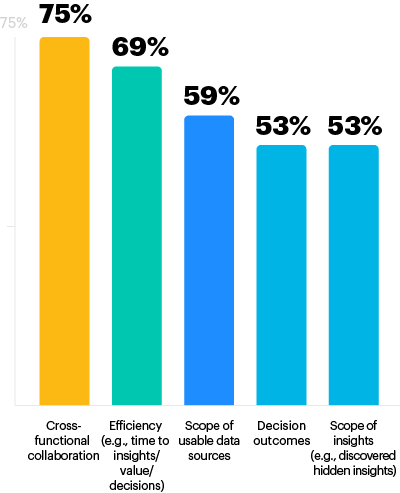Emergent Analytics: Embracing Augmented Approaches
What emerging analytics capabilities are currently supported by organizations’ analytics architectures and what benefits have leaders seen as a result?

One minute insights:
Most have or plan to adopt emerging analytics capabilities
Augmented, streaming and natural language analytics are among the most common currently supported by respondent architectures
More than two-thirds of those with emerging analytics capabilities say they led to improvements
More than half have adopted emerging analytics capabilities
51% of respondents say their organization’s analytics architecture already has emerging analytics capabilities — technologies that use cloud-enabled augmented approaches to analytics creation and consumption.
Does your organization’s analytics architecture have emerging analytics capabilities? (1)

n = 89
Question: Do you have any final thoughts to share on your organization’s analytics architecture?
Highly industry dependent. In Pharma, it appears architectures are very much catered toward legacy process (core deliverables) whereas advanced analytics is secondary.
Current capabilities include augmented, streaming and natural language analytics
Most respondents who have emerging analytics capabilities (n = 45) say their analytics architectures support augmented analytics (58%), streaming analytics (58%) or natural language analytics (51%).
What emerging analytics capabilities are currently supported by your organization’s analytics architecture? Select all that apply. (2)

Geospatial analytics 29% | Embedded and composable analytics 24% | Other capability(ies) not listed here 4% | I don’t know 4% | Prefer not to say 0% | Other 0%
n = 45
Question: Do you have any final thoughts to share on your organization’s analytics architecture?
It’s ever evolving but we are embracing ML technology, cloud-based data engineering and cloud data lakehouse and data warehousing.
Emerging analytics have led to improvements in collaboration and efficiency
Have the emerging analytics capabilities currently supported by your organization’s analytics architecture led to improvements? (2)

71% of these respondents (n = 45) say the emerging analytic capabilities currently supported by their analytics architecture have led to improvements.
n = 45
Most respondents who have seen improvements (n = 32) point to cross-functional collaboration (75%), efficiency (e.g., time to insights/value/decisions) (69%) or scope of usable data sources (59%).
What has improved as a result of the emerging analytics capabilities currently supported by your organization’s analytics architecture? Select all that apply. (3)

Customer experience 47% | Model accuracy 41% | Balance of agility and governance 38% | Innovation within data and analytics team 34% | User adoption 34% | Other area(s) not listed here 0% | Prefer not to say 0% | Other 0%
n = 32
Question: Do you have any final thoughts to share on your organization’s analytics architecture?
We have worked to create an architecture that not only aims at solving technical problems but also solves the core problems which affect the adoption. This includes solving change management issues, infra issues, leadership challenges, etc.
In their own words...
Question: Do you have any final thoughts to share on your organization’s analytics architecture?
Analytics should be frugal and people oriented.
Analytics is [the] most important piece to drive decisions based on data rather than gut feelings. It’s a constant endeavour to explore new tools and technologies.
Make sure [the] tools framework meshes with the overall architectural direction of the organization.
Respondent Breakdown

1 Full question text: Does your organization’s analytics architecture have emerging analytics capabilities (technologies that use cloud-enabled augmented approaches to analytics creation and consumption)?
2 Question shown only to respondents who answered “Yes” to “Does your organization's analytics architecture have emerging analytics capabilities (technologies that use cloud-enabled augmented approaches to analytics creation and consumption)?”
3 Question shown only to respondents who answered “Yes” to “Have the emerging analytics capabilities currently supported by your organization’s analytics architecture led to improvements?”



